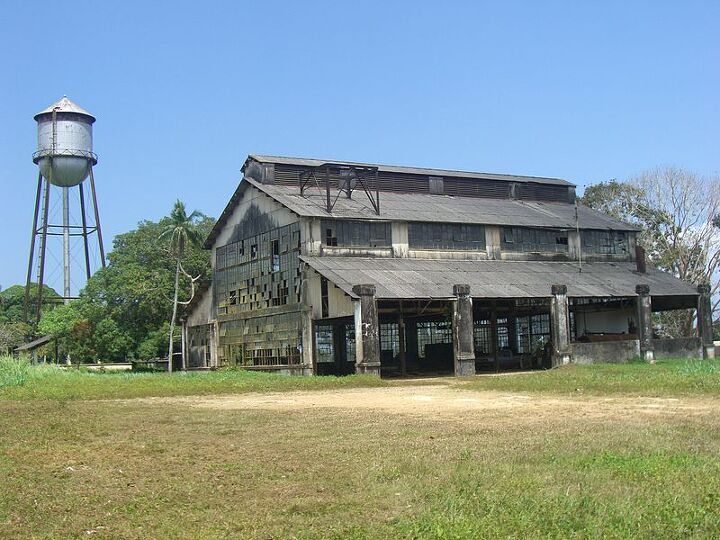Henry Ford's Bizarre Utopian Jungle Town Is a Creepy Vacation Spot

Welcome to the Paradise of Fordlândia. Three rules: no booze, no Jews, and we want to check your junk now and then.
Well, those were the rules (one of them unwritten) when the Brazilian town, hacked out of the jungle in 1928, was at its peak. Abandoned by Ford Motor Company in 1945, the bizarre utopian industrial and social experiment remains, slowly decomposing and encroached upon by vegetation, on the shores of an Amazonian backwater.
It is here, along the Tapajós river, that revolutionary industrialist and noted oddball Henry Ford created his rubber-producing settlement in the image of a modern Michigan city. Thanks to one enterprising reporter who probably owns a dog-eared copy of Heart of Darkness, we can now see what the failed experiment looks like in 2017.
To craft an in-depth piece for The New York Times, Latin American reporter Simon Romero traveled upriver to visit Fordlândia, where workers, inspected regularly for venereal disease, once staged a mutiny to protest the incessant eating of oatmeal. (I’ve always said the human brain needs meat in its diet.)
Romero does a fine job describing Ford’s vision for his mostly local workers, which included a ban on alcohol and a puritan approach to life. Outside of the home, Ford attempted to remold the environment, sending out teams to kill stray dogs, drain mosquito-breeding water and generally keep the place ship-shape.
Of course, like most utopian endeavors, Fordlândia eventually fell victim to the dream’s Kryptonite: reality. The jungle couldn’t really be tamed, and neither could man’s urges. Economics proved another sore point.
While much of the settlement has since fallen victim to age and weather, eaten up by the jungle, many homes withstood the test of time. Classy, stucco-and-tile-roof bungalows house many of the town’s remaining 2,000 occupants. The factories and surrounding plantations, which once served as Ford’s personal rubber supply before blight and overseas competition made it unprofitable, sit silently. A 100-bed hospital designed by Detroit’s Albert Kahn lies in ruins.
The town once had more. Much more. Ford built a swimming pool, movie theater, tennis courts and a golf course — everything a young, red-blooded man needed to take his mind off a daily diet of working, poetry, brown rice and absolutely no booze. Okay, maybe not everything.
Many of those who remain in Fordlândia enjoy the peace and quiet, seeing it as a low-cost way to live out the rest of their lives. Squatters take pride in home “ownership” — it’s the only reason the homes haven’t been destroyed by looters — and eke out an existence, either by waiting for the social assistance checks to arrive, or through low-key farming.
“Nothing happens here, and that’s how I like it,” said Joaquim Pereira da Silva, 73, who moved to Fordlândia 20 years ago. “The Americans had no idea about rubber but they knew how to build things to last.”
Backpacking in Europe or hitting the beaches of Thailand is boring and predictable and your friends would secretly hate you for it. If you like riverboats and damp things, and have a few weeks off this year, you now know where to go for a relaxing, Zen-like vacation.
[Image: Wikimedia Commons ( CC BY-SA 3.0)]

More by Steph Willems
Latest Car Reviews
Read moreLatest Product Reviews
Read moreRecent Comments
- UnoGeeks Great information. Unogeeks is the top SAP ABAP Training Institute, which provides the best SAP ABAP Training
- ToolGuy This thing here is interesting.For example, I can select "Historical" and "EV stock" and "Cars" and "USA" and see how many BEVs and PHEVs were on U.S. roads from 2010 to 2023."EV stock share" is also interesting. Or perhaps you prefer "EV sales share".If you are in the U.S., whatever you do, do not select "World" in the 'Region' dropdown. It might blow your small insular mind. 😉
- ToolGuy This podcast was pretty interesting. I listened to it this morning, and now I am commenting. Listened to the podcast, now commenting on the podcast. See how this works? LOL.
- VoGhost If you want this to succeed, enlarge the battery and make the vehicle in Spartanburg so you buyers get the $7,500 discount.
- Jeff Look at the the 65 and 66 Pontiacs some of the most beautiful and well made Pontiacs. 66 Olds Toronado and 67 Cadillac Eldorado were beautiful as well. Mercury had some really nice looking cars during the 60s as well. The 69 thru 72 Grand Prix were nice along with the first generation of Monte Carlo 70 thru 72. Midsize GM cars were nice as well.The 69s were still good but the cheapening started in 68. Even the 70s GMs were good but fit and finish took a dive especially the interiors with more plastics and more shared interiors.

































Comments
Join the conversation
The story is similar to a number of commodity based settlements. This experiment failed for two reasons. The first is the freedoms denied to the occupants and the second was the poor location of the settlement. A third problem would of been money or the earning potential of the settlers. There would be no chance in striking it rich. Most settlements throughout history fade away. Look at Detroit. In 1 000 years how many current cities will still be around?
There's a pretty good book by Greg Grandin about Fordlandia and, by extension, Henry Ford at the height of his influence. Recommended. The settlement failed because it never managed to produce rubber in significant quantities.